Pharmaceutical Policy Lab


The Pharmaceutical Policy Lab is an international research collaboration based within LSE Health, dedicated to evaluating, informing, and shaping pharmaceutical policies that serve the public good.
We strive to maximise the benefits and minimise the harms of medicines for patients, health systems, and societies.
Our research is interdisciplinary, drawing on knowledge, methods and perspectives from health policy, health economics, medicine, pharmacoepidemiology, sociology, political science, law, management, ethics, and communication science. We actively seek collaborations with stakeholders beyond academia to ensure our research engages with real-world challenges and achieves meaningful impact.
We are committed to rigorous science that supports informed decision-making at every stage of pharmaceutical development and use – from early scientific research and clinical trials to regulatory approval, health technology assessment, pricing, reimbursement, prescribing, patient use.
In a rapidly evolving policy landscape, we investigate the health, economic, and societal impacts of pharmaceutical policies. Through our research and collaborations, we aim to provide timely, relevant, and actionable evidence to a wide range of stakeholders, including patients, prescribers, the public, media, regulators, health technology assessment bodies, payers, industry, and policymakers.
We envision pharmaceutical policies that promote population well-being and health system sustainability. - Dr Huseyin Naci, Director, Pharmaceutical Policy Lab
Our work

Reporting of clinical trial uncertainties with new cancer drugs in journal publications and clinical guidelines
Many clinicians rely on journal publications and clinical guidelines to inform their prescribing decisions. However, it is unclear whether clinical trial uncertainties about newly approved cancer drugs are reported in these sources. This study showed that important clinical trial uncertainties highlighted in the FDA’s Benefit-Risk Framework were infrequently reported in journal publications and clinical guidelines.
Read the paper here.

Strength of evidence supporting cancer drug approvals in China between 2017 and 2021: a retrospective analysis
Well-designed pivotal clinical trials can provide robust evidence for the market authorisation of new cancer drugs, whereas lower-quality clinical evidence leads to uncertainty about drug benefits and harms. This paper found that four-fifths of pivotal studies supporting new cancer indication approvals in China from 2017 to 2021 had weaknesses in design, conduct, or reporting that introduced uncertainty to the estimation of treatment effects. A robust premarketing evaluation of investigational new cancer drugs is needed to improve certainty regarding drug benefits and harms in China.
Read the paper here.

New cancer drug approvals: less than half of important clinical trial uncertainties reported by the FDA to clinicians, 2019–22
Uncertainties about the benefits and harms of new cancer drugs are common at the time of approval. In this study, we showed that important uncertainties with the clinical trial evidence supporting new cancer drugs approvals that were identified by FDA reviewers were infrequently communicated to physicians in regulated drug labels from the FDA.
Read the paper here.
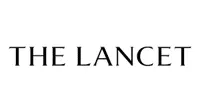
Population-health impact of new drugs recommended by the National Institute for Health and Care Excellence in England during 2000-20: a retrospective analysis.
Health systems experience difficult trade-offs when paying for new drugs. In England, funding recommendations by the National Institute for Health and Care Excellence (NICE) for new drugs might generate health gains, but inevitably result in forgone health as the funds cannot be used for alternative treatments and services. This paper showed that national health service coverage of new drugs in England displaced more health than it generated during 2000-2020. These results highlight the inherent trade-offs between individuals who directly benefit from new drugs and those who forgo health due to the reallocation of resources towards new drugs.
The findings of this paper were covered in the Financial Times, The Independent, The Telegraph, The Economist, Euronews, among others.
Read the open access paper here.

Preferences for speed of access versus certainty of the survival benefit of new cancer drugs: a discrete choice experiment
Many new cancer drugs do not offer any survival benefit to patients. In this study, individuals expressed strong preferences for certainty that a cancer drug would offer survival benefit. Some individuals also expressed a higher willingness to wait for greater certainty than would be necessary to assess the survival benefit of most cancer drugs used in the metastatic setting.
Read the open access paper here.

Treatment Effects in Randomized and Nonrandomized Studies of Pharmacological Interventions: A Meta-Analysis
Randomized clinical trials (RCTs) are widely regarded as the methodological benchmark for assessing clinical efficacy and safety of health interventions. There is growing interest in using nonrandomized studies to assess efficacy and safety of new drugs. In this study, there was no overall difference in effect size estimates between RCTs and nonrandomized studies on average, but nonrandomized studies both overestimated and underestimated treatment effects observed in RCTS and introduced additional uncertainty. These findings suggest that relying on nonrandomized studies as substitutes for RCTs may introduce additional uncertainty about the therapeutic effects of new drugs.
Read the open access paper here.

Overall survival benefits of cancer drugs initially approved by the US Food and Drug Administration on the basis of immature survival data: a retrospective analysis
New cancer drugs can be approved by the US Food and Drug Administration (FDA) on the basis of surrogate endpoints while data on overall survival are still incomplete or immature, with too few deaths for meaningful analysis. This study showed that fewer than a third of indications approved with immature survival data demonstrated a statistically significant overall survival benefit after approval. Notable inconsistencies in timing and availability of information after approval across different sources emphasise the need for better reporting standards.
Read the open access paper here.

Communication of anticancer drug benefits and related uncertainties to patients and clinicians: document analysis of regulated information on prescription drugs in Europe
To receive and participate in medical care, patients need high quality information about treatments, tests, and services—including information about the benefits of and risks from prescription drugs. This study showed that the benefits of anticancer drugs were rarely well communicated to patients in regulated information sources for prescription drugs in Europe. The findings of this study highlight the need to improve the communication of the benefits and related uncertainties of anticancer drugs in regulated information sources in Europe to support evidence informed decision making by patients and their clinicians.
The findings of this paper were covered in The Guardian.
Read the open access paper here.

The Political Economy of the World Health Organization Model Lists of Essential Medicines
The World Health Organization (WHO) Model Lists of Essential Medicines (EML) aims to help countries select medicines based on the priority needs of their populations. However, rapid evolution within the pharmaceutical sector toward complex, high-priced medicines has challenged WHO decision making, leading to inconsistent decisions. This research demonstrates that challenges facing the EML have deep roots. At the core of this issue is the role of the list. Defining a strategic vision for the WHO EML, refining decision criteria, and increasing institutional support would align interests, good processes, and, ultimately, contribute to positive societal health outcomes.
Read the open access paper here.
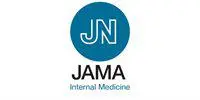
Real-world Use of and Spending on New Oral Targeted Cancer Drugs in the US, 2011-2018
Launch prices of new cancer drugs in the US have substantially increased in recent years despite growing concerns about the quantity and quality of evidence supporting their approval by the US Food and Drug Administration (FDA). This study showed that the percentage of patients receiving drugs without documented overall survival benefit increased substantially from 2011 to 2018. In 2018, cumulative spending on drugs without documented overall survival benefit exceeded that of drugs with documented overall survival benefit.
Read the paper here.

Communication of Survival Data in US Food and Drug Administration-Approved Labeling of Cancer Drugs
Overall survival—how long patients live after treatment—is the most definitive patient-relevant outcome when evaluating cancer drugs in clinical trials. Consistently communicating the association of cancer drugs with overall survival in US Food and Drug Administration (FDA)-approved labeling can help inform treatment decisions. In this study, we found substantial variation in how information on overall survival was reported in cancer drug labeling. Such variation complicates ascertaining whether a cancer drug improves overall survival in its labeled indication.
Read the paper here.
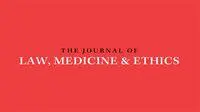
The Complex Cancer Care Coverage Environment - What is the Role of Legislation? A Case Study from Massachusetts
New anti-cancer medications come to markets at increasingly high prices, and health insurance coverage is crucial for patient access to these therapies. State laws are intended to facilitate insurance coverage of anti-cancer therapies. Using Massachusetts as a case study, we identified five current cancer coverage state laws and interviewed experts on their perceptions of the relevance of the laws and how well they meet the current needs of cancer care given rapid changes in therapies. Interviewees emphasized that cancer therapies, as compared to many other therapeutic areas, are unique because insurance legislation targets their coverage.
Read the paper here.

Approval of Cancer Drugs With Uncertain Therapeutic Value: A Comparison of Regulatory Decisions in Europe and the United States
Regulatory agencies are increasingly required to make market approval decisions for new drugs on the basis of limited clinical evidence, a situation commonly encountered in cancer. This study showed that US and European regulators often deemed early and less complete evidence on benefit-risk profiles of cancer drugs sufficient to grant regular approval, raising questions over regulatory standards for the approval of new medicines. Even when imposing confirmatory studies in the postmarketing period through special approval pathways, meaningful evidence may not materialize due to shortcomings in study design and delays in conducting required studies with due diligence.
Read the open access paper here.
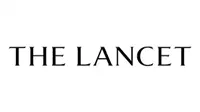
Generating comparative evidence on new drugs and devices before approval
Fewer than half of new drugs have data on their comparative benefits and harms against existing treatment options at the time of regulatory approval in Europe and the USA. This paper proposed a set of five key principles relevant to the European Medicines Agency, European medical device regulatory agencies, US Food and Drug Administration, as well as payers, that we believe will provide the necessary incentives for pharmaceutical and device companies to generate comparative data on drugs and devices and assure timely availability of evidence that is useful for decision making. First, labelling should routinely inform patients and clinicians whether comparative data exist on new products. Second, regulators should be more selective in their use of programmes that facilitate drug and device approvals on the basis of incomplete benefit and harm data. Third, regulators should encourage the conduct of randomised trials with active comparators. Fourth, regulators should use prospectively designed network meta-analyses based on existing and future randomised trials. Last, payers should use their policy levers and negotiating power to incentivise the generation of comparative evidence on new and existing drugs and devices, for example, by explicitly considering proven added benefit in pricing and payment decisions.
Read the paper here.

Design characteristics, risk of bias, and reporting of randomised controlled trials supporting approvals of cancer drugs by European Medicines Agency, 2014-16: cross sectional analysis
Most pivotal studies forming the basis of European Medicines Agency (EMA) approval of new cancer drugs between 2014 and 2016 were randomised controlled trials. However, almost half of these were judged to be at high risk of bias based on their design, conduct, or analysis, some of which might be unavoidable because of the complexity of cancer trials. Regulatory documents and the scientific literature had gaps in their reporting. Journal publications did not acknowledge the key limitations of the available evidence identified in regulatory documents.
Read the open access paper here.

Availability of evidence of benefits on overall survival and quality of life of cancer drugs approved by European Medicines Agency: retrospective cohort study of drug approvals 2009-13
This systematic evaluation of oncology approvals by the European Medicines Agency (EMA) in 2009-13 shows that most drugs entered the market without evidence of benefit on survival or quality of life. At a minimum of 3.3 years after market entry, there was still no conclusive evidence that these drugs either extended or improved life for most cancer indications. When there were survival gains over existing treatment options or placebo, they were often marginal.
Findings of this paper were covered in The Guardian.
Read the open access paper here.
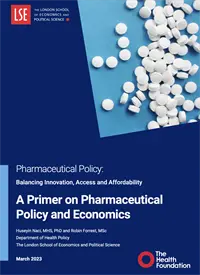
A Primer on Pharmaceutical Policy and Economics
A global overview of the pharmaceutical sector and the economics involved.
Read here.
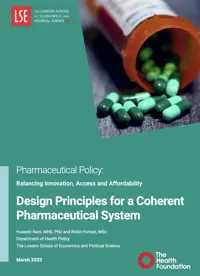
Design Principles for a Coherent Pharmaceutical System
Defining the principles needed to build a coherent pharmaceutical system.
Read here.
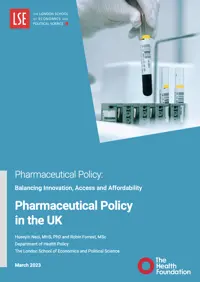
Pharmaceutical Policy in the UK
An in-depth overview of the pharmaceutical policy landscape in the UK.
Read here.
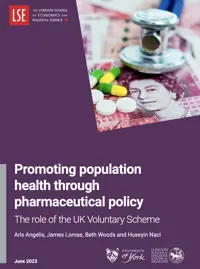
Promoting Population Health through Pharmaceutical Policy
The role of the voluntary agreement between the UK government and the pharmaceutical industry in ensuring access and affordability.
Read here.
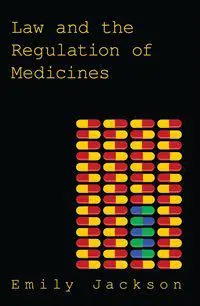
Law and the Regulation of Medicines
Professor Emily Jackson
LSE Law School
The principal purpose of this book is to tell the story of a medicine's journey through the regulatory system in the UK, from defining what counts as a medicine, through clinical trials, licensing, pharmacovigilance, marketing and funding. The question of global access to medicines is addressed because of its political importance, and because it offers a particularly stark illustration of the consequences of classifying medicines as a private rather than a public good.
Two further specific challenges to the future of medicine's regulation are examined separately: first, pharmacogenetics, or the genetic targeting of medicines to subgroups of patients, and second, the possibility of using medicines to enhance well-being or performance, rather than treat disease.
Throughout, the emphasis is on the role of regulation in shaping and influencing the operation of the medicines industry, an issue that is of central importance to the promotion of public health and the fair and equitable distribution of healthcare resources. [Description from the publisher’s site]
See it on the publisher’s site here.

Coalitions and Compliance: The Political Economy of Pharmaceutical Patents in Latin America
Professor Kenneth C. Shadlen
LSE Department of International Development
Coalitions and Compliance examines how international changes can reconfigure domestic politics. Since the late 1980s, developing countries have been subject to intense pressures regarding intellectual property rights. These pressures have been exceptionally controversial in the area of pharmaceuticals. Historically, fearing the economic and social costs of providing private property rights over knowledge, developing countries did not allow drugs to be patented. Now they must do so, an obligation with significant implications for industrial development and public health. This book analyses different forms of compliance with this new imperative in Latin America, comparing the politics of pharmaceutical patenting in Argentina, Brazil, and Mexico.
Coalitions and Compliance focuses on two periods of patent politics: initial conflicts over how to introduce drug patents, and then subsequent conflicts over how these new patent systems function. In contrast to explanations of national policy choice based on external pressures, domestic institutions, or Presidents' ideological orientations, this book attributes cross-national and longitudinal variation to the ways that changing social structures constrain or enable political leaders' strategies to construct and sustain supportive coalitions. The analysis begins with assessment of the relative resources and capabilities of the transnational and national pharmaceutical sectors, and these rival actors' efforts to attract allies. Emphasis is placed on two ways that social structures are transformed so as to affect coalition-building possibilities: how exporters fearing the loss of preferential market access may be converted into allies of transnational drug firms, and differential patterns of adjustment among state and societal actors that are inspired by the introduction of new policies. It is within the changing structural conditions produced by these two processes that political leaders build coalitions in support of different forms of compliance. [Description from the publisher’s site]See it on the publisher’s site here.

Why Pharmaceutical Pricing Needs Reform
The health benefits of new drugs do not sufficiently offset the health benefits lost due to disinvestment from existing treatments and services.
Read the blog on the British Politics and Policy blog here.

Patients deserve better information on new drugs
Drug regulatory agencies should improve their oversight and direct provision of relevant, useful, and trustworthy information on new drugs.
Read the article on The BMJwebsite (requires subscription) here.
Author submitted version available on the LSE Research Online repository here.

Specialty Drugs - A Distinctly American Phenomenon
Various stakeholders in the pharmaceutical supply chain assign the specialty label to drugs. But the single most common feature of specialty drugs is high cost.
Read the article on The New England Journal of Medicinewebsite (requires subscription) here.
Author submitted version available on the LSE Research Online repository here.


Ethical implications of poor comparative effectiveness evidence: obligations in industry-research partnerships
Measurable ethical obligations to patients should form the core of future comparative effectiveness research in an era of personalised medicine.
Read the article on The Lancet website (requires subscription) here.
Author submitted version is freely available on the LSE Research Online repository here.


Unintended Consequences of Coverage Laws Targeting Cancer Drugs
"Onco-exceptionalism" in coverage policy poses challenges for payers confronted with high-cost drugs with limited evidence on clinical benefits.
Read the article on the Journal of Law, Medicine & Ethicswebsite (requires subscription) here.
Author submitted version is freely available on the LSE Research Online repository here.

Inappropriate use of progression-free survival in cancer drug approvals
New drugs should be judged on overall survival or quality of life, preferably both.
Read the article on The BMJwebsite (requires subscription) here.


Communication of information on drug benefits, risks, and uncertainties
Our aim is to enhance the communication of regulated information about new drugs in the United States. We plan to design and test improvements to existing communication strategies and explore alternative approaches.
Project team: Huseyin Naci (LSE), Anita Wagner (Harvard), Steven Woloshin (Dartmouth), Courtney Davis (KCL), Avi Cherla (LSE), Florence Bourgeois (Harvard)
Funder: Arnold Ventures

Population health impact of new drugs adopted by Medicare
Our aim is to quantify the net health effects across different therapy areas and estimate the net population health impact of new drugs adopted by Medicare.
Project team:Huseyin Naci (LSE), Irene Papanicolas (Brown University School of Public Health), James Lomas (York), Daniel Ollendorf (ICER)
Funder:The National Institute for Health Care Management (NIHCM) Foundation

Economics of drug development in cardiovascular medicine
Pharmaceutical research and development in cardiovascular diseases is hibernating. We aim to evaluate the economic, regulatory, and health system factors driving drug development in cardiovascular disease.
Project team: Huseyin Naci (LSE), Elias Mossialos (LSE), Robin Forrest (LSE), Aroon Hingorani (UCL)
Funder: UK National Institute for Health and Care Research
Our team

Founder and Director, Pharmaceutical Policy Lab; Associate Professor, Department of Health Policy; Deputy Director, LSE Health

Co-founder, Pharmaceutical Policy Lab; Reader in Global Health and Social Medicine, Department of Global Health and Social Medicine, King’s College London

Co-founder, Pharmaceutical Policy Lab; Associate Professor of Population Medicine, Department of Population Medicine, Harvard Medical School; Director, Center for Cancer Policy and Program Evaluation, Harvard Pilgrim Health Care Institute

Co-founder, Pharmaceutical Policy Lab; Professor of Medicine, Dartmouth Geisel School of Medicine

Co-founder, Pharmaceutical Policy Lab; Senior Research Fellow, Centre for Health Economics, University of York

Co-founder, Pharmaceutical Policy Lab; Senior Lecturer, Department of Economics and Related Studies, University of York

Co-founder, Pharmaceutical Policy Lab; Assistant Professor of Drug Regulatory Science, Center for Pharmaceutical Policy and Regulation, Utrecht University

Co-founder, Pharmaceutical Policy Lab; Deputy Head, Pharmacoeconomics, Gesundheit Österreich GmbH / Austrian National Public Health Institute



Professor of Development Studies, Department of International Development, LSE

Cheng Yu Tung Chair in Global Health, Department of Health Policy; Director, LSE Health

Director of Harvard-MIT Center for Regulatory Science, Harvard Medical School; Associate Professor of Pediatrics, Harvard Medical School


Professor of Pharmaceutical Policy, Dean, Department of Pharmacy Administration and Clinical Pharmacy, School of Pharmaceutical Sciences, Peking University. International Research Centre for Medicinal Administration, Peking University

Instructor, Department of Population Medicine, Harvard Medical School; Director, Center for Cancer Policy and Program Evaluation, Harvard Pilgrim Health Care Institute

Research Fellow, Department of Pharmacy Administration and Clinical Pharmacy, School of Pharmaceutical Sciences, Peking University


Associate Professor, Brown University School of Public Health

Research Fellow, Department of Population Medicine, Harvard Medical School; PhD candidate, Department of Health Policy, LSE

Research Fellow, Department of Population Medicine, Harvard Medical School; PhD candidate, Department of Health Policy, LSE




For more information, please contact Dr Huseyin Naci at H.Naci@lse.ac.uk.